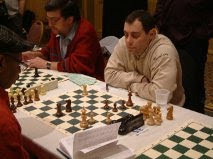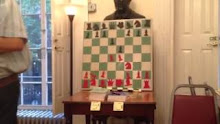The safest way for Black to meet the exchange variation is by deploying his KB to d6, his KN to e7, and his KBP to f6. By so doing, he takes away the e5 square from White's KN and avoids the pin of his KN by White's QB on g5. But Black is still not out of the woods unless he remembers to develop his QB to f5 to neutralize White's KB on d3, instead of pinning White's KN by bringing his QB to g4. Some games of mine will illustrate these points.
My game as White against Boris Privman (USCF 2288) at the Marshall Chess Club in November 1998 shows how White gains a small but significant advantage when Black's KN is on f6 instead of e7. The opening moves were 1.e4 e6 2.d4 d5 3.exd5 exd5 4.Nf3 Nf6 5.Bd3 Bd6 6.O-O O-O 7.Nc3 c6 8.Bg5 Bg4 9.h3 Bh5 10.g4 Bg6 11.Ne5.
Now Black's next move 11...Bxd3?! was inaccurate, although many of my opponents have played it. Probably they feared 12.Nxg6. But this capture would only help Black, since White would be giving up his powerful knight and forcing his KB on d3 to "bite on granite" after 12...hxg6. The game continued 12.Qxd3 Nbd7 13.Nxd7 Qxd7 14.Bxf6 gxf6 15.Rae1 Rae8 16.Re3 Kg7 17.Rfe1 Bf4 18.Rxe8 Rxe8 19.Rxe8 Qxe8, leaving White with a good square on f5 for both his queen and knight.
After the further moves 20.Qe2 Qe6 21.Kg2 b6 22.Kf3 Bg5 23.Qd3 Qd6 24.Kg2 Qb4 25.b3 Bf4 26.a4 a5 27.Ne2 Bc7 28.f4 Qd6 29.Ng3 Qe6 30.Qf5 Kf8 31.Kf3 c5 32.dxc5 bxc5 33.Qxh7 Ke7 34.Qd3 Kd8 35.Nf5 Kc8 36.Qe2 Kd7 37.Qxe6+ fxe6 38.Ne3 Ke7 39.h4 Kf7 40.f5 Be5 41.fxe6+ Kxe6 42.h5 d4 43.Nc4, White had a decisive advantage and won in 74 moves.
An even more inaccurate handling of the Black pieces was seen in my game against Eric Cooke (USCF 2315) at the Marshall Chess Club in September 1999. Not only did Cooke make the same mistakes as Privman by playing ...Nf6 and ...Bxd3, but he compounded his problems by poorly developing his KB. First he brought it to e7, then to d6, then back to e7, and finally blundered the game by moving it to d6 yet again. Here are the moves: 1.e4 e6 2.d4 d5 3.exd5 exd5 4.Nf3 Nf6 5.Bd3 Bg4 6.O-O Be7 7.Re1 O-O 8.Bg5 h6?! 9.Bh4 Bd6 10.Nc3 c6 11.h3 Bh5 12.g4 Bg6 13.Ne5 Bxd3 14.Qxd3 Be7 15.Re2 Nbd7 16.Rae1 Re8 17.Qf5 Nf8 18.g5 hxg5 19.Bxg5 N8h7 20.h4 Qd6 21.Bf4 Qd8 22.h5 Bd6?
Now White had the winning continuation 23.Nxf7! Kxf7 24.Rxe8 Qd7 25.Qg6#. Of course, 22...Bd6? was a bad move. But even after Cooke's post-game suggestion of 22...Qc8, White would stand better following 23.Qxc8 Raxc8 24.Nxc6! bxc6 25.Rxe7 Rxe7 26.Rxe7 Nxh5 27.Bh2.
An opening trap with which I have snared many adversaries occurred in my game against Juan Sena (USCF 2210) at the Manhattan Chess Club in May 1998 after the opening moves 1.e4 e6 2.d4 d5 3.exd5 exd5 4.Nf3 Bg4 5.Bd3 Nf6 6.O-O Be7 7.Re1 O-O 8.Bg5 Nc6 9.c3 Ne4?! 10.Bxe7 Qxe7 11.Nbd2 f5 12.Qb3.
Black loses a pawn by force due to the pin on the a2-g8 diagonal. Sena struggled on with 12...Qd6, but after 13.Bxe4 fxe4 14.Nxe4 Qd7 15.Ned2 Na5 16.Qc2 Qf7 17.Re3 Rae8 18.Rxe8 Qxe8 19.Re1 Qf7 20.Re3 Bxf3 21.Rxf3 Qh5 22.Rxf8+ Kxf8 23.Nf1 Nc4 24.b3 Nd6 25.f3, White had a winning position (although it took 70 moves to score the point).
In a similar manner, I defeated Tom Shih (USCF 2100) at the Somerset NJ quads in September 1998: 1.e4 e6 2.d4 d5 3.exd5 exd5 4.Nf3 Nf6 5.Bd3 Be7 6.O-O O-O 7.Bg5 Bg4 8.Nbd2 Ne4?! 9.Bxe7 Qxe7 10.Re1 f5 11.c3 Qd8 12.Qb3.
White won a pawn anyway after 12...Nxd2 13.Nxd2 b6 14.f3 Bh5 15.Re5 Bf7 16.Bxf5 and went on to win in 77 moves.
Another popular development of the Black pieces happened in my game against Yuri Ashuev (USCF 2007) at the Marshall Chess Club in May 1999. It involves kingside castling by White and queenside castling by Black. White's attack seems the more dangerous after 1.e4 e6 2.d4 d5 3.exd5 exd5 4.Nf3 Bd6 5.Bd3 Bg4 6.O-O Nc6 7.c3 Qd7 8.Re1+ Nge7 9.Nbd2 O-O-O 10.b4 Ng6 11.Qa4 Kb8 12.b5 Nce7 13.Ba3 Nf4 14.Bf1.
Even so, the game eventually leveled off after 14...f6 15.Bc5 Nc8 16.Qb3 Qf5 17.Re3 Qh5 18.c4 Bxc5 19.dxc5 d4 20.Re4 Ne6 21.Qa3 Bxf3 22.Nxf3 Qxc5 23.Qxc5 Nxc5 24.Rxd4 Rxd4 25.Nxd4 Nd6 26.Nb3 Nxb3 27.axb3 Rd8 28.Rd1 c6 29.bxc6 bxc6 30.c5 Nb7 31.Rxd8+ Nxd8 32.Bd3 h6 33.b4 Nb7 34.Ba6 Nd8 35.Kf1 Ne6 36.Bc4 Nd4 37.Bd3 a5! 38.bxa5 Nb3 39.Ke2 Nxc5 40.Bc4 Ka7 41.Ke3 Nb7 42.a6 Nd6 43.Be2 c5 and was drawn in 55 moves.
As mentioned above, Black's safest path to a draw is the deployment of his QB to f5. A good example of this is my game from the USATE 1998 against Ernes Encarnacion (USCF 2239) which went as follows: 1.e4 e6 2.d4 d5 3.exd5 exd5 4.Nf3 Bd6 5.Bd3 Ne7 6.O-O O-O 7.Re1 Bf5 8.Bg5 Bxd3 9.Qxd3 Nbc6 10.c3 f6 11.Bh4 Qd7 12.Bg3 Nf5.
Now, a wholesale exchange of pieces ensued:13.Bxd6 Nxd6 14.Nbd2 Qf7 15.Re2 Rfe8 16.Rae1 Rxe2 17.Rxe2 Re8 18.Rxe8+ Qxe8 19.Kf1 Nd8 20.Qe2 Kf7 21.Qxe8+, draw.
An almost identical game took place against Eric Ross (USCF 2120) at the Hamilton NJ quads in October 1997: 1.e4 e6 2.d4 d5 3.exd5 exd5 4.Nf3 Bd6 5.Bd3 Ne7 6.O-O O-O 7.Re1 Bf5 8.Bg5 Bxd3 9.Qxd3 Nbc6 10.c3 f6 11.Bh4 Qd7 12.Bg3.
Instead of 12...Nf5, Black tried a different plan but with the same result after 12...Bxg3 13.hxg3 Rae8 14.Nbd2 Nd8 15.Re2 Nf5 16.Rae1 Nd6 17.Kf1 Rxe2 18.Rxe2 Re8 19.Rxe8+, draw.
In closing, here are some games that are far from perfect but illustrate the possibilities for both sides in this opening.
Game #1: Jim West (USCF 2227) - Ed Koss (USCF 2100), USATE 1998
1.e4 e6 2.d4 d5 3.exd5 exd5 4.Nf3 Nf6 5.Bd3 Bd6 6.O-O O-O 7.Nc3 c6 8.Bg5 Bg4 9.h3 Be6 10.Ne5 Nbd7 11.f4 Qb6 12.Nxd7 Bxd7 13.Bxf6 gxf6 14.Qh5 Qxd4+ 15.Kh1 f5 16.Rf3 Qf6 17.Raf1 Kh8 18.Rg3 Rg8 19.Rg5 Rxg5 20.Qxg5 Be7 21.Qh5 Qg6 22.Qf3 Rg8 23.Ne2 c5 24.Nc3 Bc6 25.Nxd5 Bd6 26.c4 h5 27.Rf2 h4 28.b3 Re8 29.Re2 Re6 30.Qf2 Rxe2 31.Qxh4+ Kg7 32.Bxe2 Bxd5 33.cxd5 f6, 1-0 (time).
Game #2: Jim West (USCF 2232) - Tom Shih (USCF 2123), Somerset NJ 1998
1.e4 e6 2.d4 d5 3.exd5 exd5 4.Nf3 Be7 5.Bd3 Nf6 6.O-O O-O 7.Bg5 Nbd7 8.Re1 h6 9.Bh4 b6 10.Nbd2 c5 11.c3 Bb7 12.Bf5 Re8 13.Qc2 Nf8 14.Re3 g6 15.Rae1 Kg7 16.Bxf6+ Kxf6 17.Bh3 Bc8 18.Ne5 Bxh3 19.Rxh3 Kg7 20.Ndf3 (20.Rxh6!?) Bf6 21.Qd2 h5 22.g4 hxg4 23.Qh6+ Kg8 24.Nxg4 Rxe1+ 25.Nxe1 Bg7 26.Qf4 Qe7 27.Nf3 Ne6 28.Qe3 Re8 29.Nh6+ Kf8 30.Ne5 Bxe5 31.dxe5 Qg5+ 32.Rg3 Qxe3 33.Rxe3 d4 34.cxd4 cxd4 35.Ra3 Re7 36.Ng4 Nf4 37.f3 Ne6 38.Nf6 Kg7 39.h4 Rc7? 40.Ne8+ Kf8 41.Nxc7 Nxc7 42.Rd3 Ne6 43.Kf1 a6 44.Ra3 a5 45.Rb3 Nc5 46.Rxb6 Ke7 47.Rb5 Nd3 48.Ke2 Nc1+ 49.Kd2 Nxa2 50.Rxa5 Nb4 51.Rb5 Nc6 52.Rc5 Nd8 53.Kd3 Ne6 54.Rc4, 1-0.
Game #3: Jim West (USCF 2232) - Louis Leiggi (USCF 2086), Somerset NJ 1998
1.e4 e6 2.d4 d5 3.exd5 exd5 4.Nf3 Bd6 5.Bd3 Qe7+ 6.Be3 Nf6 7.O-O O-O 8.Bg5 h6 9.Re1 Qd8 10.Bh4 Bg4 11.Nbd2 c5 12.dxc5 Bxc5 13.h3 Be6 14.Nb3 Bb6 15.Nbd4 Bd7 16.c3 Nc6 17.Nxc6 bxc6 18.Ne5 g5 19.Bg3 Bc5 20.Qf3 Be7 21.Nxd7 Qxd7 22.Be5 Kg7 23.Re2 Rg8 24.Rae1 Rae8 25.Bd4 Bd8 26.Rxe8 Rxe8 27.Rxe8 Qxe8 28.Qf5 Qe1+ 29.Kh2 Bc7+ 30.g3 Bxg3+ 31.fxg3 Qd2+ 32.Kg1 Qe1+ 33.Kg2 Qd2+ 34.Bf2, 1-0 (time).
{This article originally appeared in the Summer 2000 issue of Empire Chess}




























